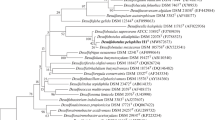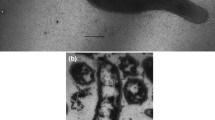Abstract
A thermophilic sulfate-reducing vibrio isolated from thermal vent water in Yellowstone Lake, Wyoming, USA is described. The gram-negative, curved rod-shaped cells averaged 0.3 μm wide and 1.5 μm long. They were motile by means of a single polar flagellum. Growth was observed between 40° and 70 °C with optimal growth at 65 °C. Cultures remained viable for one year at 27 °C although spore-formation was not observed. Sulfate, thiosulfate and sulfite were used as electron acceptors. Sulfur, fumarate and nitrate were not reduced. In the presence of sulfate, growth was observed only with lactate, pyruvate, hydrogen plus acetate, or formate plus acetate. Pyruvate was the only compound observed to support fermentative growth. Pyruvate and lactate were oxidized to acetate. Desulfofuscidin and c-type cytochromes were present. The G+C content was 29.5 mol%. The divergence in the 16S ribosomal RNA sequences between the new isolate and Thermodesulfobacterium commune suggests that these two thermophilic sulfate-reducing bacteria represent different genera. These two bacteria depict a lineage that branches deeply within the Bacteria domain and which is clearly distinct from previously defined phylogenetic lines of sulfate-reducing bacteria. Strain YP87 is described as the type strain of the new genus and species Thermodesulfovibrio yellowstonii. Yellowstone Lake (Wyoming, USA) is located within one of the most tectonically active regions in the world (Klump et al. 1988; Remsen et al. 1990). Hydrothermal springs, hot gas fumaroles and elevated substrata temperatures have been observed within the lake itself (e.g., Remsen et al. 1990). Hydrothermal vent waters were reported to be anoxic, high in dissolved nutrients relative to the lake water and to have temperatures in excess of 80 °C (Klump et al. 1988; Remsen et al. 1990). Sulfate concentrations averaged 380 μM in vent waters and 80 μM in bulk lake water (Klump et al. 1988; Remsen et al. 1990). On the basis of on these physical and chemical characteristics, and the observation (e.g., Zeikus et al. 1983) that microbial sulfate reduction is prevalent in the thermal aquatic environments of Yellowstone National Park, we hypothesized that hydrothermal vent waters in Yellowstone Lake could support the growth of thermophilic sulfate reducers.
Here we describe the general characteristics of a new thermophilic sulfate reducing bacterium, Thermodesulfovibrio yellowstonii, which was isolated from hydrothermal vent water in Sedge Bay of Yellowstone Lake, Wyoming, USA. In addition, we report on the phylogenetic relationship of this new isolate with other thermophilic and mesophilic sulfate-reducing bacteria.
Similar content being viewed by others
References
Achenbach-Richter L, Gupta R, Stetter KO, Woese CR (1987) Were the original eubacteria thermophiles? Syst Appl Microbiol 9: 34–39
Bergmeyer HU (1974) Methoden der enzymatischen Analyse, 3rd edn. Verlag Chemie, Weinheim
Burggraf S, Olsen GJ, Stetter KO, Woese CR (1992) A phylogenetic analysis of Aquifex pyrophilus. Syst Appl Microbiol 15: 352–356
Campbell LL, Postgate JR (1965) Classification of the sporeforming sulfate-reducing bacteria. Bacteriol Rev 29: 359–363
Cline JD (1969) Spectrophotometric determination of hydrogen sulfide in natural waters. Limnol Oceanogr 14: 454–458
Cole RM, Popkin TJ (1981) Electron microscopy. In: Gerhardt P, Murray RGE, Costilow RN, Nester EW, Wood WA, Krieg NR, Phillips GB (eds) Manual of methods for general bacteriology. American Society for Microbiology, Washington DC, pp 34–51
Daumas S, Cord-Ruwisch R, Garcia JL (1988) Desulfotomaculum geothermicum sp. nov., a thermophilic fatty acid-degrading, sulfate-reducing bacterium isolated with H2 from geothermal groundwater. Antonie van Leeuwenhoek; J Microbiol Serol 54: 165–178
De Soete G (1983) A least squares algorithm for fitting additive trees to proximity data. Psychometrika 48: 621–626
Devereux R, Delaney M, Widdel F, Stahl DA (1989) Natural relationships among sulfate-reducing eubacteria. J Bacteriol 171: 6689–6695
Devereux R, He S-H, Doyle CL, Orkland S, Stahl DA, LeGall J, Whitman WB (1990) Diversity and origin of Desulfovibrio species: phylogenetic definition of a family. J Bacteriol 172: 3609–3619
Fassel TA, Schaller MJ, Lidstrom ME, Remsen CC (1990) Effect of fixation-resin combinations and ruthenium red on elucidating outer envelope structure and surface morphology of two methanotrophic bascteria. J Electron Microsc Techn 14: 52–62
Fowler VJ, Widdel F, Pfennig N, Woese CR, Stackebrandt E (1986) Phylogenetic relationships of sulfate- and sulfur-reducing bacteria. Syst Appl Microbiol 8: 32–41
Hatchikian EC, Zeikus JG (1983) Characterization of a new type of dissimilatory sulfite reductase present in Thermodesulfobacterium commune. J Bacteriol 153: 1211–1220
Heimbrook ME, Wang WLL, Campbell G (1989) Staining bacterial flagella easily. Clin Microbiol 27: 2612–2615
Klump JV, Remsen CC, Kaster JL (1988) The presence and potential impact of geothermal activity on the chemistry and biology of Yellowstone Lake, Wyoming. In: DeLuca MP, Babb I (eds) Global venting, midwater, and benthic ecological processes. NOAA National Undersea Res Program Res Rep: 88-4, 81–98
Lane DJ, Pace B, Olsen GJ, Stahl DA, Sogin ML, Pace NR (1985) Rapid determination of 16S ribosomal RNA sequences for phylogenetic research. Proc Natl Acad Sci USA 82: 6955–6959
Maki JS, Remsen CC (1983) A membrane adsorption-SEM technique for observing neuston organisms. Microbial Ecol 9: 177–183
Mandel M, Marmur J (1968) Use of ultraviolet absorbance temperature profile for determining the guanine plus cytosine content of DNA. Methods Enzymol 12B: 195–206
Marmur J (1961) A procedure for the isolation of deoxyribonucleic acid from micro-organisms. J Mol Biol 3: 208–218
Min H, Zinder SH (1990) Isolation and characterization of a thermophilic sulfate-reducing bacterium Desulfotomaculum thermoacetoxidans sp. nov. Arch Microbiol 153: 399–404
Möller-Zinkhan D, Thauer RK (1990) Anaerobic lactate oxidation to 3 CO2 by Archaeoglobus fulgidus via the carbon monoxide dehydrogenase pathway: demonstration of the acetyl-CoA carbon cleavage reaction in cell extracts. Arch Microbiol 153: 215–218
Möller-Zinkhan D, Börner G, Thauer RK (1989) Function of methanofuran, tetrahydromethanopterin, and coenzyme F420 in Archaeoglobus fulgidus. Arch Microbiol 152: 362–368
Nazina TN, Ivanova AE, Kanchaveli LP, Rozanova EP (1988) A new sporeforming thermophilic methylotrophic sulfate-reducing bacterium, Desulfotomaculum kuznetsovii sp. nov. Mikrobiologiya 57: 823–827 [English transl. 57: 659–663]
Ørskov F (1984) Genus I. Escherichia Castellani and Chalmers 1919, 941. In: Krieg NR, Holt JG (eds) Bergey's manual of systematic bacteriology, vol 1. Williams & Wilkins, Baltimore, pp 420–423
Pfennig N (1978) Rhodocyclus purpureus, gen. nov. and sp. nov., a ring shaped, vitamin B12-requiring member of the family Rhodospirillaceae. Int J Syst Bacteriol 28: 283–288
Pfennig N, Wagener S (1986) An improved method of preparing wet mounts for photomicrographs of microorganisms. J Microbiol Methods 4: 303–306
Postgate JR (1959) A diagnostic reaction of Desulphovibrio desulphuricans. Nature 183: 481
Remsen CC, Klump JV, Kaster J, Paddock R, Anderson P, Maki JS (1990) Hydrothermal springs and gas fumaroles in Yellowstone Lake, Yellowstone National Park, Wyoming. Nation Geograph Res 6: 509–515
Reynolds E (1963) The use of lead citrate at high pH as an electron opaque stain in electron microscopy. J Cell Biol 17: 208–212
Rozanova EP, Khudyakova AI (1974) A new nonspore-forming thermophilic sulfate-reducing organism, Desulfovibrio thermophilus nov. sp. Mikrobiologiya 43: 1069–1075 [English transl. 43: 908–912]
Rozanova EP, Pivovarova TA (1988) Reclassification of Desulfovibrio thermophilus (Rozanova, Khudyakova, 1974). Mikrobiologiya 57: 102–106 [English transl. 57: 85–89]
Schauder R, Eikmanns B, Thauer RK, Widdel F, Fuchs G (1986) Acetate oxidation to CO2 in anaerobic bacteria via a novel pathway not involving reactions of the citric acid cycle. Arch Microbiol 145: 162–172
Stahl DA, Flesher B, Mansfield HR, Montgomery L (1988) Use of phylogenetically based hybridization probes for studies of ruminal microbial ecology. Appl Environ Microbiol 54: 1079–1084
Stetter KO (1988) Archaeoglobus fulgidus, gen. nov., sp. nov.: a new taxon of extremely thermophilic archaebacteria. Syst Appl Microbiol 10: 172–173
Tabatabai MA (1974) Determination of sulfate in water samples. Sulphur Inst J 10: 11–13
Tasaki M, Kamagata Y, Nakamura K, Mikami E (1991) Isolation and characterization of a thermophilic benzoate-degrading, sulfate-reducing bacterium, Desulfotomaculum thermobenzoicum, sp. nov. Arch Microbiol 155: 348–352
Weisburg WG, Tully JG, Rose DL, Petzel JP, Oyaizu H, Yang D, Mandelco L, Sechrest J, Lawrence TG, Van Etten J, Maniloff J, Woese CR (1989a) A phylogenetic analysis of the mycoplasmas: basis for their classification. J Bacteriol 171: 6455–6467
Weisburg WG, Giovannoni SJ, Woese CR (1989b) The Deinococcus-thermus phylum and the effect of rRNA composition on the phylogenetic tree construction. Syst Appl Microbiol 11: 128–134
Widdel F, Bak F (1992) Gram-negative mesophilic sulfate-reducing bacteria. In: Balows A, Trüper HG, Dworkin M, Harder W, Schleifer K-H (eds) The prokaryotes: a handbook on the biology of bacteria; ecology, physiology, identification, applications, 2nd edn. Springer, New York Berlin Heidelberg, pp 3352–3378
Widdel F, Pfennig N (1981) Studies on dissimilatory sulfate-reducing bacteria that decompose fatty acids. I. Isolation of new sulfate-reducing bacteria enriched with acetate from saline environments. Description of Desulfobacter postgatei gen. nov., sp. nov. Arch Microbiol 129: 395–400
Widdel F, Pfennig N (1984) Dissimilatory sulfate- or sulfur-reducing bacteria. In: Krieg NR, Holt JG (eds) Bergey's manual of systematic bacteriology, vol 1. William & Wilkins, Baltimore, pp 663–679
Widdel F, Kohring G-W, Mayer F (1983) Studies on dissimilatory sulfate-reducing bacteria that decompose fatty acids. III. Characterization of the filamentous gliding Desulfonema limnicola, gen. nov. sp. nov. and Desulfonema magnum sp. nov. Arch Microbiol 134: 286–294
Woese CR, Sogin M, Stahl DA, Lewis BJ, Bonen L (1976) A comparison of the 16S ribosomal RNAs from mesophilic and thermophilic bacilli. J Mol Evol 7: 197–213
Woese CR, Achenbach L, Rouviere P, Mandelco L (1991) Archael phylogeny: reexamination of the phylogenetic position of Archaeoglobus fulgidus in light of certain composition-induced artifacts. Syst Appl Microbiol 14: 364–371
Yang DC, Kaine BP, Woese CR (1985) The phylogeny of archaebacteria. Syst Appl Microbiol 6: 251–256
Zeikus JG, Dawson MA, Thompson TE, Ingvorsen K, Hatchikian EC (1983) Microbial ecology of volcanic sulphidogenesis: isolation and characterization of Thermodesulfobacterium commune, gen. nov. and sp. nov. J Gen Microbiol 129: 1159–1169
Author information
Authors and Affiliations
Additional information
Dedicated to the memory of Friedhelm Bak
Rights and permissions
About this article
Cite this article
Henry, E.A., Devereux, R., Maki, J.S. et al. Characterization of a new thermophilic sulfate-reducing bacterium. Arch. Microbiol. 161, 62–69 (1994). https://doi.org/10.1007/BF00248894
Received:
Accepted:
Issue Date:
DOI: https://doi.org/10.1007/BF00248894




